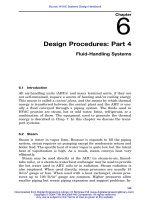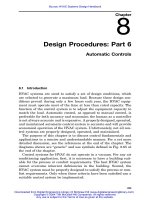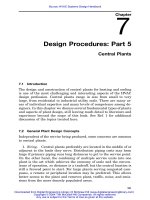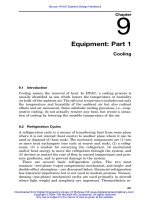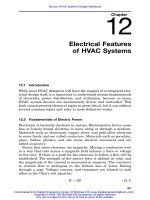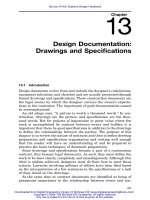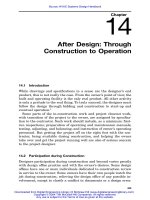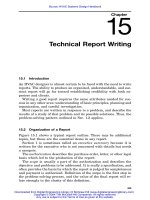HVAC Systems Design Handbook part 13
Bạn đang xem bản rút gọn của tài liệu. Xem và tải ngay bản đầy đủ của tài liệu tại đây (269.66 KB, 18 trang )
411
Chapter
13
Design Documentation:
Drawings and Specifications
13.1 Introduction
Design documents evolve from and include the designer’s calculations,
equipment selections, and sketches and are usually presented through
formal drawings and specifications. These construction documents are
the legal means by which the designer conveys the owner’s expecta-
tions to the contractor. The importance of good documentation cannot
be overemphasized.
An old adage says, ‘‘A picture is worth a thousand words.’’ In con-
struction, drawings are the picture, and specifications are the thou-
sand words. But for projects of importance or great value where the
work is accomplished by contract between owner and builder, it is
important that there be good specifications in addition to the drawings
to define the relationships between the parties. The purpose of this
chapter is to review the nature of contracts and then to define drawing
preparation and specification organization and writing well enough
that the reader will have an understanding of and be prepared to
practice the basic techniques of document preparation.
Since drawings and specifications become a part of a construction
contract, they become legal documents. As such, they must define the
work to be done clearly, completely, and unambiguously. Although this
ideal is seldom achieved, designers must do their best to meet these
criteria. Lawsuits involving millions of dollars have been filed based
on the interpretation of a few sentences in the specifications or a lack
of clear detail on the drawings.
At the same time as contract documents are identified as being of
paramount importance to the relationship between owner and con-
Source: HVAC Systems Design Handbook
Downloaded from Digital Engineering Library @ McGraw-Hill (www.digitalengineeringlibrary.com)
Copyright © 2004 The McGraw-Hill Companies. All rights reserved.
Any use is subject to the Terms of Use as given at the website.
412 Chapter Thirteen
tractor, remember that document preparation has a cost which must
be reasonable and a schedule which must be met. No project has an
infinite amount of time or resources which can be allocated to the
design effort. The result is that documents should be adequate, but
not overdone, should be prepared deftly and in an organized fashion,
all arranged to fully reflect the owner’s hopes and the designer’s in-
tent.
13.2 The Nature of Contracts
In the United States, the law allows two or more individuals or com-
panies or institutions to contract with each other for an exchange of
goods or services. In HVAC work, a building owner, called the owner,
will typically arrange with a vendor or installer, called the contractor,
to furnish and install equipment and related material in a system.
Often the HVAC work is performed in conjunction with the full com-
plement of building construction. The agreement between the owner
and the contractor contains the basic elements of any legal contract;
i.e., there is a work or service of value committed to deliver, there is
compensation for the work performed, and there is a time period of
performance. All three components are required to establish a valid
contract.
Most construction is undertaken by contract, where the specifica-
tions and drawings define the work to be done and the contract in-
cludes a description of compensations and a date of completion. There
are often penalties for failure to perform in a timely manner and some-
times bonuses for early completion.
Persons signing the contract must be authorized to do so. This is
self-evident in the case of a private individual, a proprietorship, or a
partnership. In the case of a corporation, the board of directors must
have given authority to the signator for his or her signature to be valid
and binding on the company. Signatures are often witnessed or nota-
rized.
13.3 Drawings
As already noted, contract drawings are legal documents and thus
should avoid ambiguity. This consideration leads to several criteria
which are typical of good drawings.
The efforts take design time. The alternative—providing inadequate
information, neglecting details, and careless checking—can take a
great deal more time later on, can cost money for extras, and even can
lose the confidence of the client in the designer’s competence.
Design Documentation: Drawings and Specifications
Downloaded from Digital Engineering Library @ McGraw-Hill (www.digitalengineeringlibrary.com)
Copyright © 2004 The McGraw-Hill Companies. All rights reserved.
Any use is subject to the Terms of Use as given at the website.
Design Documentation: Drawings and Specifications 413
13.3.1 Drawing size and scale
Drawing size and scale should be appropriate for the work being de-
scribed. Typical drawing sheet sizes are described both by letter and
by sheet dimension.
Size Dimension
A8
1
⁄
2
ϫ 11
B11ϫ 17
C18ϫ 24
D24ϫ 36 (22 ϫ 34)
E30ϫ 42
F36ϫ 48
Special sizes may be custom-ordered. Smaller sheets can be included
in a book of specifications. Larger sheets are almost always presented
as a set, except in the case of only one or two sheets, where they may
be neatly folded and placed in pockets in the specification book.
The drawing scale is determined by the amount of detail to be pre-
sented for the dominant aspects of the work. For building construction,
1
⁄
8
in ϭ 1 ft is a common scale. A very large building may have a plan
view at
1
⁄
16
in ϭ 1 ft for an overview and routing of major systems,
with sectionalized drawings at larger scale. Note that doubling a scale
uses 4 times the drawing area to make the presentation.
A common plan dimension for commercial and institutional con-
struction is
1
⁄
8
in ϭ 1 ft. For residential floor plans and for layouts
needing more detail and near-dimensional accuracy than can be ex-
pected of
1
⁄
8
- and
1
⁄
16
-in scales,
1
⁄
4
in ϭ 1 ft is used. Many mechanical
room layouts are presented at
1
⁄
4
-in scale. When much detailed pre-
sentation is needed, larger scales such as
1
⁄
2
in ϭ 1 ft,
3
⁄
4
in ϭ 1 ft,
1inϭ 1 ft, 1
1
⁄
2
in ϭ 1 ft, and 3 in ϭ 1 ft are employed. For no apparent
reason, many civil engineers involved in construction use
3
⁄
32
-,
3
⁄
16
-,
and
3
⁄
8
-in scales. No matter which scale is chosen, it is helpful and
important for all members of the design team to use common scale(s).
This helps to avoid errors and makes the overall drawing set easier
to read and interpret.
13.3.2 Drawing character
Line work, whether hand-drawn or computer- or plotter-generated,
should be clear, sharp, and accurate. Lettering should be neat, uni-
form, and legible. The appearance of the drawings can go far to es-
tablish the credibility—the acceptance or the lack of acceptance—of
the product, which is the design. Early in the development of
computer-aided design (CAD) techniques, it was felt that computer-
Design Documentation: Drawings and Specifications
Downloaded from Digital Engineering Library @ McGraw-Hill (www.digitalengineeringlibrary.com)
Copyright © 2004 The McGraw-Hill Companies. All rights reserved.
Any use is subject to the Terms of Use as given at the website.
414 Chapter Thirteen
generated drawings lacked the ‘‘character’’ of well-presented hand-
drawn work. But over time, with improved software and increased
CAD drafter skills, computer-generated drawings can have all the
character of hand-drawn work plus a greater degree of consistency and
accuracy.
13.3.3 Adequate information
Enough views, both plan and section, should be drawn to fully present
the work. Details should be numerous and explicit. Standard details
are often useful and save time, as long as the application is really
standard. Failure to tailor standards to actual conditions can be an
embarrassing, even costly experience.
13.3.4 Drawing legends
Symbols and abbreviations should be defined in a legend. There are
many regional or office-specific legends, but no universally accepted
industry standards, although ASHRAE, among others, has suggested
a set of symbols in the ASHRAE Handbook Fundamentals.
1
Several
government agencies have standards of their own which they require
to be used on their projects.
13.3.5 Diagrammatic drawings
Schematic diagrams for system flow and control are very helpful to
both the installer and the user. A complete and detailed schematic will
answer most questions about concept and performance. Such diagrams
are sometimes referred to as flow diagrams, isometrics, or P&I (pro-
cess and instrumentation) diagrams.
13.3.6 Schedules
Equipment schedules with tabular equipment performance informa-
tion should be on the drawings rather than in the specifications. Ex-
perience shows that the installer often doesn’t have (or doesn’t refer
to) the specifications. After the job is completed, the drawings are al-
most always available while specifications have a way of disappearing.
Equipment schedules then become a valuable resource for the owner.
Some design offices include full equipment specifications on the draw-
ings, but this seems to take more document preparation time and may
make it more difficult to coordinate drawings and specifications if
changes are needed.
Design Documentation: Drawings and Specifications
Downloaded from Digital Engineering Library @ McGraw-Hill (www.digitalengineeringlibrary.com)
Copyright © 2004 The McGraw-Hill Companies. All rights reserved.
Any use is subject to the Terms of Use as given at the website.
Design Documentation: Drawings and Specifications 415
13.3.7 Minimize sources of information
A good rule for presentation of quantitative information is to show it
only once on the drawings and not to call out information on the draw-
ings that is covered in the specifications, or vice versa. This reduces
the potential for error as well as the amount of information which
must be updated when changes are made.
13.3.8 Quality control—checking
Drawings should be carefully checked for errors and omissions, pref-
erably by the system designer. Some offices use an independent
checker to take a fresh look at the near-final product.
13.3.9 Use of computers in drafting
The use of computers in design, drafting, and specification writing has
proliferated in recent years.
2
Computer-aided design and drafting
(CADD) systems are available for lease or purchase or on a timeshar-
ing basis from computer service companies. As software has become
more sophisticated, the systems have become easier to use. However,
to use these systems requires a considerable investment in equipment
and in training of personnel. A CADD system, properly designed and
used, will almost always save time and money eventually, but time
and costs may increase initially during the learning period. Many gov-
ernment agencies and private institutions are so committed to CADD
that such capability is a requirement to obtain work.
13.4 Specifications
Most of the construction industry now uses a format developed by the
Construction Specifications Institute (CSI) for specifications.
3
This is
a standardized outline of contract and construction material with
forms for the contract work and with section and subsection numbers
for each technical topic. The system includes flexibility for adding in-
formation unique to a project. For details, contact the Construction
Specifications Institute, 601 Madison St., Alexandria, Virginia 22314.
See Fig. 13.1.
13.4.1 Contractual matters, or boilerplate
Preceding the technical specifications, which with the drawings define
the actual work to be accomplished, there is usually additional docu-
mentation which establishes the contractual relationship between the
Design Documentation: Drawings and Specifications
Downloaded from Digital Engineering Library @ McGraw-Hill (www.digitalengineeringlibrary.com)
Copyright © 2004 The McGraw-Hill Companies. All rights reserved.
Any use is subject to the Terms of Use as given at the website.
416 Chapter Thirteen
Figure 13.1
Masterformat.
Design Documentation: Drawings and Specifications
Downloaded from Digital Engineering Library @ McGraw-Hill (www.digitalengineeringlibrary.com)
Copyright © 2004 The McGraw-Hill Companies. All rights reserved.
Any use is subject to the Terms of Use as given at the website.
Design Documentation: Drawings and Specifications 417
Figure 13.1
(Continued )
Design Documentation: Drawings and Specifications
Downloaded from Digital Engineering Library @ McGraw-Hill (www.digitalengineeringlibrary.com)
Copyright © 2004 The McGraw-Hill Companies. All rights reserved.
Any use is subject to the Terms of Use as given at the website.
